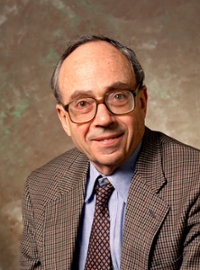

|

|
IN MEMORIAM
Stanley Mandelstam
Professor of Physics, Emeritus
UC Berkeley
1928 – 2016
Stanley Mandelstam, professor emeritus of physics at the University of California, Berkeley, passed away on June 11, 2016, at the age of 87. He was born to Beatrice (Liknaitzky) and Boris on December 12, 1928, in Johannesburg, South Africa. Boris had come from Riga, Latvia, in 1913 and was a grocer. Beatrice was born in Johannesburg and was a school teacher. He spent his childhood in Glencoe (a small town in the Natal Midlands), attended high school in the neighboring town of Dundee, and moved back to Johannesburg after graduating from high school.
In 1952, Mandelstam earned his first degree at University of the Witwatersrand (Wits), in Johannesburg. At his mother’s urging, it was a vocational degree – in chemical engineering. He never used that credential. As his nephew, Ian Abramson, a mathematician at UC San Diego, noted, “at that point Stanley was fixed on his first love, mathematical physics, and all his future studies were focused there.”
Mandelstam earned his B.A. at Trinity College, University of Cambridge, in 1954 and
his Ph.D. from Birmingham University in 1956. After a year’s research appointment at Birmingham (1956-1957) and a year as a Boese Fellow at Columbia University (1957-1958), he joined UC Berkeley in 1958 as an assistant research physicist. He returned to Birmingham to become professor of mathematical physics (1960-1963) and came back to Berkeley in 1963 to accept an appointment as professor of physics, retiring as professor emeritus in 1994. He was also an emeritus faculty member of the Berkeley Center for Theoretical Physics (BCTP).
Mandelstam’s field of research was particle theory, specifically string theory. In 1958, he devised a particle coding known as Mandelstam Variables, a way of representing the energy, momentum, and scattering angles of particles. His most recent research interests included finding an explicit expression for the n-loop superstring amplitude and proving that it is finite; he was also interested in the results of Seiberg and Witten in supersymmetric field theories.
In 1991, Mandelstam received the esteemed Dirac Medal from the International Centre for Theoretical Physics, Trieste, Italy, an award granted to only a few of the most outstanding living theoretical physicists. That same year, Professor Emeritus of Physics Bruno Zumino (a recipient of the Dirac Medal in 1987) wrote of Mandelstam: “He has resolved the problem of ambiguities in superstring theory and has shown the finiteness of the perturbation expansion. These are extremely important results, as demonstrated by the prestigious meetings where Stanley was invited to describe them.” Mandelstam was elected to the American Academy of Arts and Sciences in 2012.
“Stanley Mandelstam was simply a giant in theoretical physics. He made a tremendous amount of fundamental contributions to the development of quantum field theory and string theory,” said Professor Yasunori Nomura, Director of the BCTP. “There are famous objects called Mandelstam Variables, which every student learning theoretical physics knows. He made crucial contributions throughout virtually all aspects of quantum field theory and string theory, including the early bootstrap program, the Regge theory, and supersymmetric field theories. But it took some time for me to realize this (even after I joined the Berkeley theory group as a postdoc), because he never banged his own drum.”
During his tenure as a professor of physics at UC Berkeley, Mandelstam was one of the few particle physics theorists who regularly taught undergraduate courses. He was known as a brilliant, patient, and humble instructor who found joy in helping his students make physics “come alive.” As one student put it at the time: “He is undoubtedly in that small category of theorists who have built our current knowledge base. … In spite of Professor Mandelstam’s accomplished grasp of physics and patience as a teacher, his most prominent characteristic is his humility. He is the only person I know who does not refer to the Mandelstam Variables by their so-designated name.” Among his students at Berkeley were Joseph Polchinski, Michio Kaku, Charles Thorn, and Nathan Berkovits.
In her book, A Singularly Unfeminine Profession, Professor Emerita Mary K. Gaillard (also a member of the BCTP) wrote: “This theory (‘N = 4 supersymmetry’) was in fact proven to be finite in 1987 by our Berkeley colleague, Stanley Mandelstam. Stanley, who was already famous for his work on scattering theory, was so modest that nobody in our group knew that he had made this discovery… .” After Mandelstam’s death, Gaillard referenced what she had written about him: “It is just a beautiful example of Stanley's modesty in the face of his remarkable contributions to physics.”
Stanley is survived by his devoted sister, Gerta (Mandelstam) Abramson, her husband, also named Stanley, and their two sons, Ian (Ph.D. Statistics, UC Berkeley, 1981) and Darryl, a dentist. All live in San Diego.
Steven E. Boggs
2016